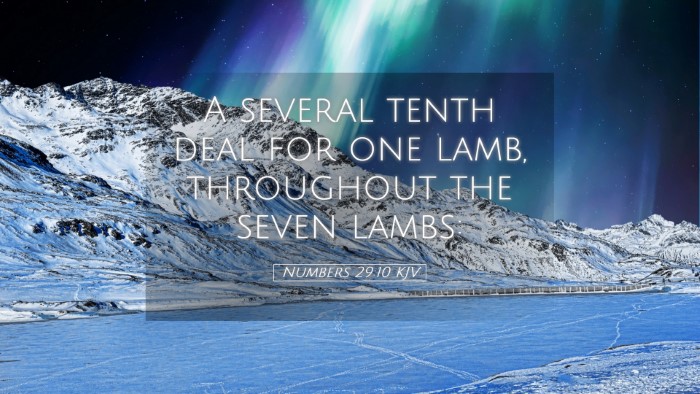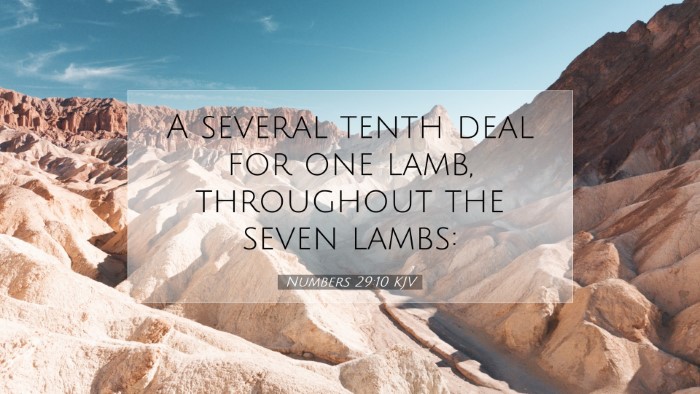Commentary on Numbers 29:10
Bible Verse: "And one young bullock, and one ram, and seven lambs of the first year, without blemish, shall be for a burnt offering unto the LORD, and their meat offering and their drink offerings, according unto the manner, and a kid of the goats for a sin offering." (Numbers 29:10)
Introduction
This verse is part of the detailed sacrificial instructions given to the Israelites as part of their annual feasts. These offerings were not merely ritualistic; they had profound spiritual implications, expressing thanksgiving, atonement for sin, and commitment to God. Understanding Numbers 29:10 requires examining the context of sacrificial practices in the Mosaic Law and the importance of these offerings in Israelite worship.
Contextual Overview
The Book of Numbers serves as a pivotal point in the Pentateuch, detailing the experiences of the Israelites during their wilderness wanderings. Numbers 29 presents the regulations concerning the feast of Tabernacles (Sukkot), a time of joy and celebration, during which the Israelites recalled their dependence on God while dwelling in the wilderness. The offerings stipulated reflect the communal nature of worship and the need for atonement.
Insights from Commentaries
Matthew Henry's Commentary
Matthew Henry highlights the spiritual significance of the offerings, noting that they are a representation of both gratitude and the acknowledgment of sin. He emphasizes the importance of the bullock, ram, and lambs in the sacrificial system as they symbolize different aspects of worship:
- The Bullock: Represents strength and is significant for offerings that denote atonement and reconciliation.
- The Ram: Suggests dedication and represents a more mature offering that signifies commitment to God's covenant.
- The Lambs: Every lamb represents innocence and purity, crucial for the sin offerings, highlighting the requirement of blamelessness in approaching God.
Henry reinforces that these offerings, particularly during the Feast of Tabernacles, demonstrate the collective worship of the community, uniting them in their faith journey.
Albert Barnes' Notes
Albert Barnes further elucidates the procedural aspects of the verse, stating that the offerings mentioned were prescribed as part of a broader ritual established by God. He notes that:
- The burnt offering represents total consecration to God, symbolizing the believer's complete surrender.
- The sin offering (the kid of the goats) underlines the need for atonement, a theme prevalent throughout the entire sacrificial system.
Barnes asserts that understanding these offerings within communal worship enhances our comprehension of corporate atonement and intercession, pivotal concepts for both Old and New Testament believers.
Adam Clarke's Commentary
Adam Clarke offers a more detailed view on the specific types of sacrifices and their purposes. He points out that:
- Each type of offering serves a dual purpose, not only for appeasement of God but also as communal acts that instill a sense of unity among the Israelites.
- The meticulous adherence to "without blemish" ensures the highest standards in offering to God, reflecting His holiness and the Israelites' respect.
Clarke posits that this attention to detail in offerings can inform modern-day worship practices, encouraging believers to consider the quality and intention behind their gifts to God.
The Theological Implications
The theological implications of Numbers 29:10 are profound. First, it illustrates the principle of substitutionary atonement, which is foundational to the sacrificial system. Each offering below also underscores the nature of God as both just and merciful. Moreover, this Scripture anticipates, in a typological manner, the ultimate sacrifice of Christ, who embodied the perfect Lamb without blemish.
Conclusion
Numbers 29:10 enriches our understanding of worship and the sacrificial system in the Old Testament. Through the insights of Matthew Henry, Albert Barnes, and Adam Clarke, we gain a multifaceted perspective on how these offerings communicate themes of worship, atonement, and communal responsibility. For pastors, students, theologians, and Bible scholars, this verse serves as a reminder of the continued relevance of atonement in Christian doctrine and the call to live a life of total consecration to God.


